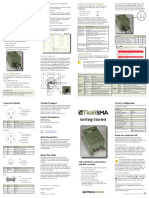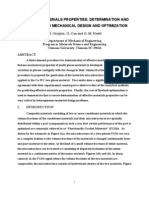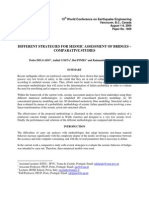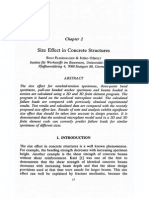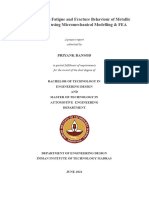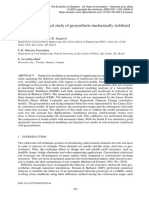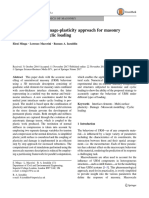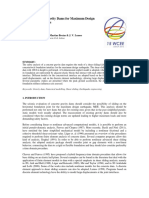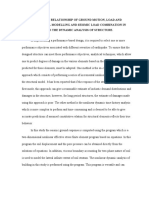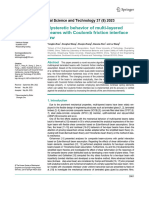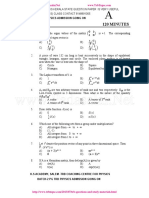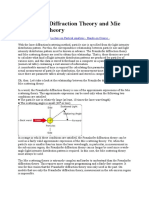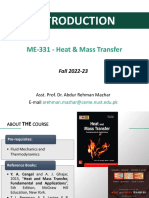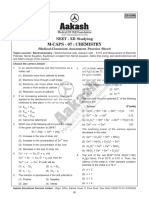Earthquake Risk Reduction and Seismic Safety Evaluation of Arch Dams Using Infinite Elements
Earthquake Risk Reduction and Seismic Safety Evaluation of Arch Dams Using Infinite Elements
Uploaded by
Gianfranco TacoCopyright:
Available Formats
Earthquake Risk Reduction and Seismic Safety Evaluation of Arch Dams Using Infinite Elements
Earthquake Risk Reduction and Seismic Safety Evaluation of Arch Dams Using Infinite Elements
Uploaded by
Gianfranco TacoOriginal Description:
Original Title
Copyright
Available Formats
Share this document
Did you find this document useful?
Is this content inappropriate?
Copyright:
Available Formats
Earthquake Risk Reduction and Seismic Safety Evaluation of Arch Dams Using Infinite Elements
Earthquake Risk Reduction and Seismic Safety Evaluation of Arch Dams Using Infinite Elements
Uploaded by
Gianfranco TacoCopyright:
Available Formats
th
The 14 World Conference on Earthquake Engineering
October 12-17, 2008, Beijing, China
EARTHQUAKE RISK REDUCTION AND SEISMIC
SAFETY EVALUATION OF ARCH DAMS USING INFINITE ELEMENTS
Ali Noorzad1, H. Mirzabozorg2, M. Ghaemian3
1
Corresponding Author, Assistant Professor, Faculty of Water Engineering, Water and Power University of
Technology, Tehran, Iran, email: noorzad@pwut.ac.ir
2
Assistant Professor, Department of Civil Engineering, KN-Toosi University of Technology, Tehran, Iran, email:
mirzabozorg@kntu.ac.ir
3
Associate Professor, Department of Civil Engineering, Sharif University of Technology, Tehran, Iran, email:
ghaemian@sharif.edu
ABSTARCT:
Uncertainty in seismic behavior of arch dams due to the effect of foundation and reservoir interaction is an
important issue in the seismic safety evaluation of existing dams. In the present paper, a direct time domain
procedure is used for dynamic analysis of the coupled system of reservoir-dam-foundation in 3D space. In the
present paper, it is attempted to simulate the foundation radiation effect on the system by infinite elements and
the reservoir water is assumed to be compressible. Material nonlinearity of the mass concrete is modeled by
smeared crack approach which is able to simulate the non-uniform cracking within the finite elements of the dam
body. Amir-kabir arch dam in Iran is chosen as a case study to investigate the nonlinear seismic behavior of the
coupled system. It is realized that the crack profiles within the dam body are less when the foundation is
assumed massed. It is found that the proposed numerical algorithm is useful in seismic safety evaluation of arch
dams in 3D space and the assumptions in the pertinent environments within the coupled problem are more
realistic. Due to the reduction of the seismic response of the coupled system, it is expected to reduce the seismic
risk of dams using more real assumptions in the numerical models.
KEYWORDS: Concrete arch dams, Dam-reservoir-foundation Interaction, Earthquake risk reduction, Infinite
elements, Non-linear behavior, Safety evaluation
1. INTRODUCTION
Design and seismic safety evaluation of concrete dams is major task in the engineering field due to the vast
socio-economic disasters which may be caused by collapse of these infrastructures. Several numerical models
have been developed for seismic design and safety evaluation of concrete dams in the two and three-dimensional
space. In the article presented by Mirzabozorg et al. (2007) some recent studies in the field of foundation
interaction effects are given. Amung them, Tan and Chopra (1995a and b) used the boundary element method to
compute the impedance matrix and they analyzed the dam-reservoir foundation in the frequency domain. Gaun
et al. (1994) presented the efficient numerical procedure in the time domain in which the dam is modeled using
the finite element method and the dynamic soil-structure interaction is included to compute the impedance
function of the half-space. Recently, Ghaemian et al. (2006) studied the effects of the foundation shape and mass
on the linear seismic response of arch dams using finite element method including structure-reservoir interaction.
In the present paper, an appropriate 3D infinite element is utilized to simulate the radiation damping on the farend boundary of the foundation medium. In addition, the smeared crack approach presented in Mirzabozorg et
al. (2007) is utilized to model the nonlinear behavior of the mass concrete. The staggered displacement method
is used to solve the coupled problem of the dam-reservoir-foundation system. The developed numerical
algorithm is utilized to simulate the nonlinear behavior of arch dams including the massed foundation, semi
infinite media at the far end boundary of the foundation and the compressible reservoir behind the dam body.
th
The 14 World Conference on Earthquake Engineering
October 12-17, 2008, Beijing, China
2. CONSTITUTIVE LAW FOR MASS CONCRETE
The numerical model used for the nonlinear seismic analysis of the mass concrete in the present study can be
found in Mirzabozorg et al. (2007). The utilized numerical approach is able to simulate the behavior of the
system during the following phases:
Pre-softening behavior
Fracture energy conservation
Non-linear behavior during the softening phase
Crack closing/reopening behavior.
It is worth noting that the proposed model falls into Co-axial Rotating Crack Model (CRCM) category.
3. FOUNDATION MEDIUM
One of the main aspects in the seismic loading and wave propagation within the semi-infinite media such as rock
media underlying structures is to prevent the wave reflection from the artificial boundary of the infinite media in
the finite element analysis. Using the infinite elements, the stiffness and the damping pertinent to the semiinfinite media via the artificial boundary of the structure are accounted for in the analyses. There will be two sets
of shape functions, the standard shape function, Ni, and a growth shape function, Mi. The growth shape function,
Mi, grows without any limitation as the coordinate of i-th node approaches infinity, and is applied to the
geometry. The standard shape functions Ni are applied to the field variables. A classic example is the line
element which is depicted in Figure 1.
Figure 1 Line element 1-2-3 of infinite element
The geometric properties within the element are interpolated as
x = M 1 x1 + M 2 x 2
M1 =
(3.1)
2
1+
,M 2 =
1
1
(3.2)
The formation of the property matrices (i.e. the stiffness matrix) proceeds in the standard method, except the
mapping function M 1 and M 2 are used to form the Jacobian matrix, [J]. According to Bettes (1992), the
growth shape functions, Mi, and their derivatives are presented in Table 1 for a 20-node solid element with a face
in the infinity as shown in Figure 2.
Figure 2 Solid element with one face in infinity
th
The 14 World Conference on Earthquake Engineering
October 12-17, 2008, Beijing, China
Table 1 Growth shape functions and their derivatives for one face in the infinity
The effect of semi-infinite media at the far-end boundary of the foundation is taken into account when the
obtained stiffness matrices and their related proportional damping matrices are assembled into the global
stiffness matrix and the global damping matrix of the system.
4. FLUID- STRUCTURE INERACTION AND THE COUPLED PROBLEM
The governing equation in the reservoir media is Helmoltz equation from the Eulers equation.
2 p =
1 2 p
C 2 t 2
(4.3)
where p , C and t are the hydrodynamic pressure, pressure wave velocity in the liquid and time, respectively.
Boundary conditions required to apply on the reservoir media to solve Eqn. 4.3 are explained in Mirzabozorg et
al. (2003). In addition, a detailed definition of matrices and vectors used has been provided in Mirzabozorg et al.
(2003). The coupled equation of dam-reservoir is solved using the staggered displacement method.
th
The 14 World Conference on Earthquake Engineering
October 12-17, 2008, Beijing, China
5. FINITE ELEMENT IMPLEMENTATION AND NUMERICAL SOLUTION
The 20-node iso-parametric brick finite elements are implemented to model the structure, mathematically. The
requirement for integration and generation of the mass, stiffness and damping matrices for this type of element is
27 Gaussian points in 3*3*3 order within each element. It is worthy to note that in the smeared crack approach,
cracking process is applied on each Gaussian point within the considered element.
Based on the implemented algorithm, strains are computed and the cracking initiation criterion is checked in
each Gaussian points. Cracking in each Gaussian point is simply modeled by adjusting the modulus stiffness
matrix contribution of the considered point in the element stiffness matrix which is co-axial with the principal
strain directions.
The foundation in the near field is simulated utilizing 20-node solid elements and the infinite elements with one
face at the infinity are used to simulate the semi-infinite media via the far-end boundary of the foundation media.
Finally, the fluid domain is modeled using 8-node fluid elements in which the DOF at their nodes is the
hydrodynamic pressure. The coupled problem of the dam-reservoir-foundation system is solved using the
staggered displacement method where the nodal acceleration vector is estimated at the current time step to
compute the other components.
Amir-Kabir dam, located in Iran, has been selected as a case study to investigate the effects of the foundation
interaction on the seismic response of the structure. The dam is double curvature arch dam with the height of
168m and its crest length is 390m. The dam structure is modelled with 72 iso-parametric 20-node elements and
its foundation media surrounding the dam body is simulated using 980 elements in which the number of the
infinite elements at the far-end boundary of the foundation is 240. It should be noted that the depth of the
foundation media is about twice of the dam height in the three global directions.
The fluid is modelled using 1024 iso-parametric 8-node fluid elements and is extended about twice of the height
of the dam body in the upstream direction. Figure 3 illustrates the finite element model of the dam body and its
foundation.
Figure 3 Finite element model of the structure, the dam body and its surrounding foundation
The modulus of elasticity, Poissons ratio, the unit weight, the true tensile strength and the ratio of the apparent
to the true tensile strength, the specific fracture energy and the dynamic magnification factor applied on both the
tensile strength and the specific fracture energy are 26GPa, 0.17, 24.027kN/m3, 3.662MPa, 1.35, 150N/m and
1.20, respectively. For the foundation medium, the modulus of elasticity, Poissons ratio and the unit weight are
taken as 16.3GPa, 0.15 and 29.400kN/m3. The velocity of wave propagation and the unit weight of water in the
reservoir are assumed to be 1436m/s and 9.807kN/m3, respectively. The wave reflection coefficient of the
reservoir bottom and sides is given as 0.8, conservatively.
th
The 14 World Conference on Earthquake Engineering
October 12-17, 2008, Beijing, China
Acceleration {g}
The stiffness proportional damping is used in the analyses in which the damping ratio for the fundamental mode
is considered 10%. Applied loads on the system are the self weight, the hydrostatic pressure and the seismic
load. The values of the integration parameters in the -method are taken as =-0.2, =0.36 and =0.7. The quasilinear damping mechanism is used for the structure in the dynamic analysis in which the stiffness proportional
damping is updated during the element cracking within the dam body.
Figure 4 shows three components of the ground motion recorded at the Ab-bar station during Manjil-Iran
earthquake on 20 June 1990 which is chosen for the analyses. This record is normalized and filtered for the
Amir-Kabir dam site. The horizontal and vertical PGA at MCE level of excitation is 0.43g and 0.33g at the dam
site, respectively. It is required to mention that all the components are multiplied by 1.5 to cause crack profiles
within the dam body.
0.5
0.4
0.3
0.2
0.1
0
-0.1
-0.2
-0.3
-0.4
-0.5
0
10
11
12
13
14
15
Time {Sec}
Acceleration {g}
(a) Horizontal, upstream-downstream direction
0.5
0.4
0.3
0.2
0.1
0
-0.1
-0.2
-0.3
-0.4
-0.5
0
10
11
12
13
14
15
13
14
15
Tim e {Sec}
Acceleration {g}
(b) Horizontal, cross-stream direction
0.5
0.4
0.3
0.2
0.1
0
-0.1
-0.2
-0.3
-0.4
-0.5
0
10
11
12
Tim e {Sec}
(c) Vertical direction
Figure 4 Components of the Manjil-Iran earthquake on June 20, 1990
th
The 14 World Conference on Earthquake Engineering
October 12-17, 2008, Beijing, China
At the first load step, there is not any cracked Gaussian point due to the self-weight and the hydrostatic load. At
the second load step, the system is excited simultaneously in the three directions using the components shown in
Figure 4. Figure 5 presents the crack profiles at the three layers of the Gaussian points through the thickness of
the dam body when the foundation medium is assumed to be massless. The results of using the massed
foundation and infinite elements to model the near field of the semi-infinite medium are given in Figure 6.
Figure 5 Cracked profile within the dam body; massless foundation
Figure 6 Cracked profile within the dam body; massed foundation using infinite elements
Comparing the crack profiles shown in Figures 5 and 6, using massed foundation and infinite elements leads to
less cracked Gaussian points which seems to be real. It is worth noting that in the model with massless
foundation, the fist crack occurred at 3.39s, while, the first crack in the second model (massed foundation
including infinite elements) initiates at 6.855s. In fact, because of larger response of the structure with massless
foundation, it is in good agreement with the actual behavior.
Figure 7 compares the time history of the crown crest displacement in the three directions. It can be observed
that the model with massed foundation and infinite elements gives a lower response in comparison with the other
model.
th
The 14 World Conference on Earthquake Engineering
October 12-17, 2008, Beijing, China
(a) Upstream/Downstream direction
(b) Cross-stream direction
(c) Vertical direction
Figure7 Crest displacement of the crown cantilever
th
The 14 World Conference on Earthquake Engineering
October 12-17, 2008, Beijing, China
6. CONCLUSIONS
The effect of the semi infinite medium at the far-end boundary of the foundation and the radiation damping has
been simulated using infinite elements on the far-end boundary of the massed foundation medium. The smeared
crack approach is utilized to simulate the nonlinear behavior of the dam body and the reservoir medium has been
assumed to be compressible. The dam-reservoir-foundation system is analyzed using the staggered displacement
method. Amir-kabir double curvature arch dam in Iran is analyzed as a case study and based on the obtained
results the nonlinear response of the dam body is more severe when the foundation is assumed massless. In
addition, using massed foundation including the infinite elements at the truncated boundary leads to crack
initiation at the longer period of excitation and also to less crack profiles within the dam body. One of the main
aspects of the proposed numerical algorithm is the stability of the linear and nonlinear dynamic analyses during
the seismic excitation. Finally, based on the results of analyzing the case study, the proposed algorithm can be an
innovative method to overcome some uncertainties for design and safety evaluation of concrete dams.
REFERENCES
Gaun, F., Moore, I.D. and Lin, G. (1994). Seismic Analysis of Reservoir-Dam-Soil Systems in the
Time Domain. Computer Methods and Advances in Geo-mechanics, 917-922.
Ghaemian, M., Noorzad, A. and Moghaddam, R.M. (2006). Foundation Effect on Seismic Response of
Concrete Arch Dams Including Dam-Reservoir Interaction. European Earthquake Engineering
(EEE) 3, 49-57.
Mirzabozorg H., Khaloo A.R. and Ghaemian M. (2003). Staggered Solution Scheme for ThreeDimensional Analysis of Dam-Reservoir Interaction. Dam Engineering Journal XIV: 3, 1-33.
Mirzabozorg, H., Khaloo, A.R., Ghaemian, M. and Jalalzadeh, B. (2008). Non-Uniform Cracking in
Smeared Crack Approach for Seismic Analysis of Concrete Dams in 3D Space. Paper will be
published in European Earthquake Engineering (EEE).
Tan, H. and Chopra, A.K. (1995). Earthquake Analysis of Arch Dams Including Dam-ReservoirFoundation Rock Interaction. Earthquake Engineering and Structural Dynamics 24, 1453-1474.
Tan, H. and Chopra, A.K. (1995). Dam-Foundation Rock Interaction Effects in Frequency-Response
Functions of Arch Dams. Earthquake Engineering and Structural Dynamics 24, 1475-1489.
Bettess, P. (1992). Infinite Elements. Penshaw Press, 1st edition.
You might also like
- TitanSMA GettingStartedGuide 17203R3Document2 pagesTitanSMA GettingStartedGuide 17203R3Gianfranco Taco100% (1)
- Titan ASL TestDocument8 pagesTitan ASL TestGianfranco TacoNo ratings yet
- 95 - Effect of Nonlinearity On Dynamic Response of Earthen Dam - 2 PDFDocument8 pages95 - Effect of Nonlinearity On Dynamic Response of Earthen Dam - 2 PDFMd Asif RajaNo ratings yet
- Seismic Design and Performance of An High RCC Dam: A. Aldemir, U. Akpınar, Y. Arıcı & B. BiniciDocument10 pagesSeismic Design and Performance of An High RCC Dam: A. Aldemir, U. Akpınar, Y. Arıcı & B. BiniciManuel SueroNo ratings yet
- Finite Element Analysis of Concrete Beam Under FleDocument15 pagesFinite Element Analysis of Concrete Beam Under FleAhmedNo ratings yet
- Macro Element Analysis For SeismicDocument4 pagesMacro Element Analysis For SeismicSewGuanNo ratings yet
- 03.2019 - Effect of Shock and Vibration Preloading On The Parameters of Tear Dimples and Their ConglomeratesDocument11 pages03.2019 - Effect of Shock and Vibration Preloading On The Parameters of Tear Dimples and Their ConglomeratesFlick TornNo ratings yet
- Mo Hinh Phan Tich VC Chiu Tai Trong Dong Dat (TA) PDFDocument8 pagesMo Hinh Phan Tich VC Chiu Tai Trong Dong Dat (TA) PDFhappytiuNo ratings yet
- 11 CT 2 - 2019Document11 pages11 CT 2 - 2019Miguel FernándezNo ratings yet
- Multimodal Response Spectrum Method Analysis of Integral Abutment Curved Box Girder BridgeDocument4 pagesMultimodal Response Spectrum Method Analysis of Integral Abutment Curved Box Girder BridgeSudip ShresthaNo ratings yet
- Numerical Study of Reinforced Concrete Beam Subjected To Blast Loading Using Finite Element Package ABAQUSDocument4 pagesNumerical Study of Reinforced Concrete Beam Subjected To Blast Loading Using Finite Element Package ABAQUSJangdiniNo ratings yet
- Effective Materials Properties: Determination and Application in Mechanical Design and OptimizationDocument24 pagesEffective Materials Properties: Determination and Application in Mechanical Design and Optimizationphuong2311No ratings yet
- Utf-8''13 1609Document13 pagesUtf-8''13 1609nvngonNo ratings yet
- Approaches For The Calculation of Rayleigh Damping Coefficients For A Time-History AnalysisDocument11 pagesApproaches For The Calculation of Rayleigh Damping Coefficients For A Time-History AnalysisHamzah Al-HashemiNo ratings yet
- Size Effect in Concrete StructuresDocument28 pagesSize Effect in Concrete StructureslifeadventureNo ratings yet
- Response Analysis of Curved Bridge With Unseating Failure Control System Under Near-Fault Ground MotionsDocument8 pagesResponse Analysis of Curved Bridge With Unseating Failure Control System Under Near-Fault Ground MotionsdarealboyNo ratings yet
- Concrete Rock InterfaceDocument7 pagesConcrete Rock Interfacedyc123No ratings yet
- Mesoscopic Simulation of Failure of Morta and Concret by 3D RBSMDocument18 pagesMesoscopic Simulation of Failure of Morta and Concret by 3D RBSMSocheata channNo ratings yet
- 10.1016@j.tafmec.2020.102514 MMMMLDocument7 pages10.1016@j.tafmec.2020.102514 MMMMLdahoulamin26No ratings yet
- Main DraftDocument47 pagesMain DraftYash RaghuwanshiNo ratings yet
- 1.2.3 Damage Analysis of Masonry Structures Under Earthquake Action Using ANSYS-SoftwareDocument11 pages1.2.3 Damage Analysis of Masonry Structures Under Earthquake Action Using ANSYS-SoftwareLê TrungNo ratings yet
- Valliappan1996 PDFDocument27 pagesValliappan1996 PDFDaniel EscobarNo ratings yet
- Finite Element Analysis of Masonry Structures" Part I I - Proposed 3-D Nonlinear Microscopic ModelDocument10 pagesFinite Element Analysis of Masonry Structures" Part I I - Proposed 3-D Nonlinear Microscopic ModelramranganNo ratings yet
- Sla SettlementDocument8 pagesSla Settlementmagist23074No ratings yet
- Analisis Daya Dukung Beban Balok Beton Bertulang TDocument9 pagesAnalisis Daya Dukung Beban Balok Beton Bertulang TSyahril SaharNo ratings yet
- 23 PDFDocument12 pages23 PDFdce_40No ratings yet
- Identification of Shear Cracks in Reinforced Beams Using Finite Element Method (Ansys)Document6 pagesIdentification of Shear Cracks in Reinforced Beams Using Finite Element Method (Ansys)Hassaan Ullah KhanNo ratings yet
- Structural Damage Zones Detection by Finite Elements: September 2018Document3 pagesStructural Damage Zones Detection by Finite Elements: September 2018Gigarostom AlgerNo ratings yet
- Effect of Soil Structure Interaction On Gravity DamDocument10 pagesEffect of Soil Structure Interaction On Gravity DamAnonymous D5s00DdUNo ratings yet
- Study of Uplift Pressure Effect in Roller Compacted Concrete Gravity DamDocument18 pagesStudy of Uplift Pressure Effect in Roller Compacted Concrete Gravity DamMAZIGHI0% (1)
- Crack Detection and Vibration Behavior of Cracked Beams: P.N. Saavedra, L.A. Cuiti NoDocument9 pagesCrack Detection and Vibration Behavior of Cracked Beams: P.N. Saavedra, L.A. Cuiti Nohmsedighi459No ratings yet
- 10.1201 9781003188339-41 ChapterpdfDocument7 pages10.1201 9781003188339-41 Chapterpdfcarlos echegaray waltsNo ratings yet
- Application of Hyperstatic Reaction Method For Designing of Tunnel Permanent Lining, Part I: 2D Numerical ModellingDocument11 pagesApplication of Hyperstatic Reaction Method For Designing of Tunnel Permanent Lining, Part I: 2D Numerical ModellingIngrid Irreño PalomoNo ratings yet
- IGJ Journal PaperDocument18 pagesIGJ Journal PaperAvijit BurmanNo ratings yet
- Plastic HingeDocument20 pagesPlastic HingeNSunNo ratings yet
- A Macro-Element For Dynamic Soil-Structure Interaction Analyses of Shallow FoundationsDocument11 pagesA Macro-Element For Dynamic Soil-Structure Interaction Analyses of Shallow FoundationsdasdreadfefaNo ratings yet
- A Case Study On 3D Non-Linear Analysis of A Clay Core Rockfill Dam (#365046) - 381454Document9 pagesA Case Study On 3D Non-Linear Analysis of A Clay Core Rockfill Dam (#365046) - 381454Rajendra KunwarNo ratings yet
- An Ecient Three-Dimensional Solid Nite Element Dynamic Analysis of Reinforced Concrete StructuresDocument21 pagesAn Ecient Three-Dimensional Solid Nite Element Dynamic Analysis of Reinforced Concrete StructuresPPPNo ratings yet
- Nonlinear Seismic Analysis of RCC Dam CoDocument6 pagesNonlinear Seismic Analysis of RCC Dam CoBishowkumar ShresthaNo ratings yet
- Alsardi (2021) Runout Modeling of Earthquake Triggered Landslides With The Material Point MethodDocument18 pagesAlsardi (2021) Runout Modeling of Earthquake Triggered Landslides With The Material Point MethodZhenhe SongNo ratings yet
- A 3D Mesoscale Damage-Plasticity Approach For Masonry Structures Under Cyclic LoadingDocument21 pagesA 3D Mesoscale Damage-Plasticity Approach For Masonry Structures Under Cyclic LoadingYU NIENo ratings yet
- Diseño de PresasDocument10 pagesDiseño de PresasLuis Rizabal GamarraNo ratings yet
- 1 s2.0 S1000936123002200 MainDocument12 pages1 s2.0 S1000936123002200 MainkoemangkumangNo ratings yet
- 108 400 2 PB PDFDocument10 pages108 400 2 PB PDFIngrid Irreño PalomoNo ratings yet
- Engineering Structures 31 (2009) 999-1009Document11 pagesEngineering Structures 31 (2009) 999-1009rpatel5509No ratings yet
- Seismic Fracture Analysis of Concrete Gravity Dams Based On Nonlinear Fracture MechanicsDocument21 pagesSeismic Fracture Analysis of Concrete Gravity Dams Based On Nonlinear Fracture MechanicsJulio Humberto Díaz RondánNo ratings yet
- National Seminaroncivil Engineering Research SEPKA2011 UTMDocument11 pagesNational Seminaroncivil Engineering Research SEPKA2011 UTMravirajNo ratings yet
- Interpenetrating Phase Composites: Micromechanical ModellingDocument6 pagesInterpenetrating Phase Composites: Micromechanical ModellingLeon MishnaevskyNo ratings yet
- Ppr12 314clrDocument18 pagesPpr12 314clrDuván Amir Rueda SánchezNo ratings yet
- LIITDocument4 pagesLIITAllyson DulfoNo ratings yet
- Finite Element Upper Bound Analysis of Seismic Slope Sta - 2020 - Computers andDocument16 pagesFinite Element Upper Bound Analysis of Seismic Slope Sta - 2020 - Computers andarifyunandoNo ratings yet
- 3-A O - Vatulyan,-S A - NesterovDocument15 pages3-A O - Vatulyan,-S A - Nesterovwedha rayhanantoNo ratings yet
- E. Minga Et Al., 2020. 3D Macroelement Approach For Nonlinear FE Analysis of URM Components Subjected To In-Plane and Out-Of-Plane Cyclic LoadingDocument22 pagesE. Minga Et Al., 2020. 3D Macroelement Approach For Nonlinear FE Analysis of URM Components Subjected To In-Plane and Out-Of-Plane Cyclic LoadingMichael PisfilNo ratings yet
- Ijert Ijert: Dynamic Analysis of Tunnels in Urban Areas With and Without Support SystemsDocument6 pagesIjert Ijert: Dynamic Analysis of Tunnels in Urban Areas With and Without Support SystemsRatulKumarMajumdarNo ratings yet
- Seismic Analysis of Heap Leach Pad Liner SystemsDocument12 pagesSeismic Analysis of Heap Leach Pad Liner SystemsCarlos A. Espinoza MNo ratings yet
- VV FE Study Bridge Deck DesignDocument22 pagesVV FE Study Bridge Deck DesignMahfuzur RahmanNo ratings yet
- 【1】1 s2.0 S0032591024009306 mainDocument19 pages【1】1 s2.0 S0032591024009306 mainzxl1602676563No ratings yet
- Numerical Simulation of Parallel Hole Cut Blasting With Uncharged HolesDocument6 pagesNumerical Simulation of Parallel Hole Cut Blasting With Uncharged HolesVassilis PentheroudakisNo ratings yet
- Orthotropic Homogenized Modeling of Masonry Wall Panels: October 2020Document17 pagesOrthotropic Homogenized Modeling of Masonry Wall Panels: October 2020vadaleNo ratings yet
- MB JMSTDocument13 pagesMB JMSTzhaoyonglin466No ratings yet
- Dynamic Damage and FragmentationFrom EverandDynamic Damage and FragmentationDavid Edward LambertNo ratings yet
- Lab 7 Gravity Modeling With Gm-Sys: GEOL 481.3Document6 pagesLab 7 Gravity Modeling With Gm-Sys: GEOL 481.3Gianfranco TacoNo ratings yet
- The H/V Spectral Ratio Technique: Experimental Conditions, Data Processing and Empirical Reliability AssessmentDocument12 pagesThe H/V Spectral Ratio Technique: Experimental Conditions, Data Processing and Empirical Reliability AssessmentGianfranco TacoNo ratings yet
- Microtremor HVSR Study of Site Effects in Bursa City (Northern Marmara Region, Turkey)Document13 pagesMicrotremor HVSR Study of Site Effects in Bursa City (Northern Marmara Region, Turkey)Gianfranco TacoNo ratings yet
- 10 1 1 1028 6225 PDFDocument13 pages10 1 1 1028 6225 PDFGianfranco TacoNo ratings yet
- Determination of The Characteristic Frequency of Two Dams Located in The Region of Calabria, ItalyDocument9 pagesDetermination of The Characteristic Frequency of Two Dams Located in The Region of Calabria, ItalyGianfranco TacoNo ratings yet
- SDEE Jan2004 AtakanDocument2 pagesSDEE Jan2004 AtakanGianfranco TacoNo ratings yet
- 4236 ErDocument2 pages4236 ErGianfranco TacoNo ratings yet
- SDEE Jan2004 DuvalDocument8 pagesSDEE Jan2004 DuvalGianfranco TacoNo ratings yet
- H/V Ratio: A Tool For Site Effects Evaluation. Results From 1-D Noise SimulationsDocument11 pagesH/V Ratio: A Tool For Site Effects Evaluation. Results From 1-D Noise SimulationsGianfranco TacoNo ratings yet
- Ul2 0-6Document2 pagesUl2 0-6Gianfranco TacoNo ratings yet
- Specification Rechargeable Sealed Lead Acid Battery: MM (Inch)Document1 pageSpecification Rechargeable Sealed Lead Acid Battery: MM (Inch)Gianfranco TacoNo ratings yet
- Güralp 5T Compact: Operator's GuideDocument27 pagesGüralp 5T Compact: Operator's GuideGianfranco Taco100% (1)
- Waba Dam Permanent DeformationDocument8 pagesWaba Dam Permanent DeformationGianfranco TacoNo ratings yet
- Minimate PlusDocument2 pagesMinimate PlusGianfranco TacoNo ratings yet
- Reflex: Distance (Meter) PROFILE - 0031.RD3Document3 pagesReflex: Distance (Meter) PROFILE - 0031.RD3Gianfranco TacoNo ratings yet
- Large-Scale Exploitation of Bimodal Reaction Sequences Including Degradation - Comparison of Jet Loop and Trickle Bed ReactorsDocument8 pagesLarge-Scale Exploitation of Bimodal Reaction Sequences Including Degradation - Comparison of Jet Loop and Trickle Bed ReactorsFabiola GendusaNo ratings yet
- 16-PT5 Durst Pump DrivesDocument5 pages16-PT5 Durst Pump DrivesDiego AlbarracinNo ratings yet
- Optical Emission SpectrosDocument18 pagesOptical Emission SpectrosRajalakshmiNo ratings yet
- Advantages of Code Case 2695 and Comparison Bet ASME Div 1 and Div 2 PDFDocument42 pagesAdvantages of Code Case 2695 and Comparison Bet ASME Div 1 and Div 2 PDFPrashant Agrawal100% (1)
- Lec4 - Heat EffectsDocument7 pagesLec4 - Heat EffectsKaryl CoronelNo ratings yet
- Paper 1 PDFDocument23 pagesPaper 1 PDFDrEmadEl-SaidNo ratings yet
- NDT - Rebar Detector 2 (GPR)Document10 pagesNDT - Rebar Detector 2 (GPR)BMZNo ratings yet
- CalibrationDocument9 pagesCalibrationLuis Gonzalez100% (1)
- L9-Thermal RadiationDocument37 pagesL9-Thermal RadiationskNo ratings yet
- Homework The Gauss Law SolutionDocument6 pagesHomework The Gauss Law SolutionTikTok LikeeNo ratings yet
- Magnetic PropertiesDocument20 pagesMagnetic Propertiespatrick saliwanNo ratings yet
- Steel Member Analysis & Design - Sample Calculation (As 4100)Document9 pagesSteel Member Analysis & Design - Sample Calculation (As 4100)Tiam MarapeNo ratings yet
- Nosepiece, Which Allow The Selection of Objectives of Different Magnifications. TheseDocument8 pagesNosepiece, Which Allow The Selection of Objectives of Different Magnifications. Theserashmi_harryNo ratings yet
- Turbocharger Programme 2011 PDFDocument36 pagesTurbocharger Programme 2011 PDFAlexander Akimov100% (1)
- Crystal DefectsDocument3 pagesCrystal DefectsixbreakxawayNo ratings yet
- Powder MetallurgyDocument96 pagesPowder Metallurgykhare_girishNo ratings yet
- LAB 9 การทดสอบกำลังเฉือนโดยตรง (Direct Shear Test) - ผลการทดสอบDocument5 pagesLAB 9 การทดสอบกำลังเฉือนโดยตรง (Direct Shear Test) - ผลการทดสอบTomorrowNo ratings yet
- Problems On STMDocument4 pagesProblems On STMshanthakumargc0% (1)
- Seal Types & Gland Design: Major ClassificationsDocument6 pagesSeal Types & Gland Design: Major ClassificationsvinothNo ratings yet
- Fdocuments - in - PG TRB Physics This Kerala State Question Paper Is Very UsefuDocument15 pagesFdocuments - in - PG TRB Physics This Kerala State Question Paper Is Very UsefuGopi NathNo ratings yet
- The Causes of Shear Cracking in Prestressed Concrete Box Girder BridgesDocument10 pagesThe Causes of Shear Cracking in Prestressed Concrete Box Girder BridgesVipin Kumar ParasharNo ratings yet
- Final Year Aeronauticaltextbooks ListDocument4 pagesFinal Year Aeronauticaltextbooks ListSujith KumarNo ratings yet
- Cape Water HandoutDocument4 pagesCape Water HandoutLton LuisNo ratings yet
- Fraunhofer Diffraction Theory and Mie Scattering TheoryDocument2 pagesFraunhofer Diffraction Theory and Mie Scattering TheoryWaheed Ur RehmanNo ratings yet
- Bombas GrundfosDocument8 pagesBombas GrundfosLuis D. RodriguezNo ratings yet
- Introduction HMTDocument8 pagesIntroduction HMTAbdullah aminNo ratings yet
- SKF SPOJKE - Couplings 2015Document110 pagesSKF SPOJKE - Couplings 2015Zoran Badurina-Rumešić0% (1)
- Aakash ModuleDocument4 pagesAakash Modulearyankmsingh22No ratings yet
- Waves and SoundDocument98 pagesWaves and SoundLegdor EdralaNo ratings yet
- Gemini VII 2390 Operator Manual V3.03Document426 pagesGemini VII 2390 Operator Manual V3.03PablosNo ratings yet
